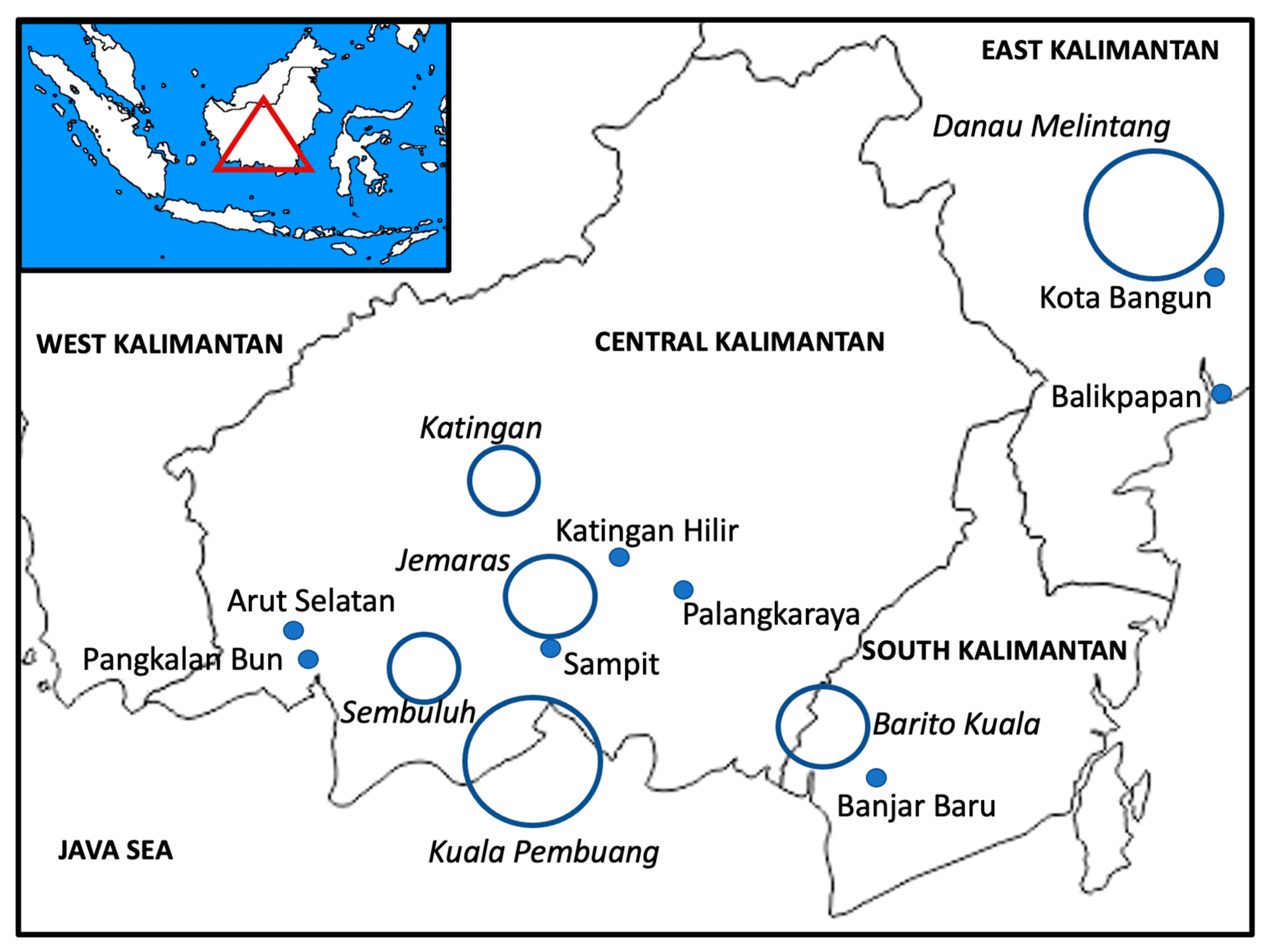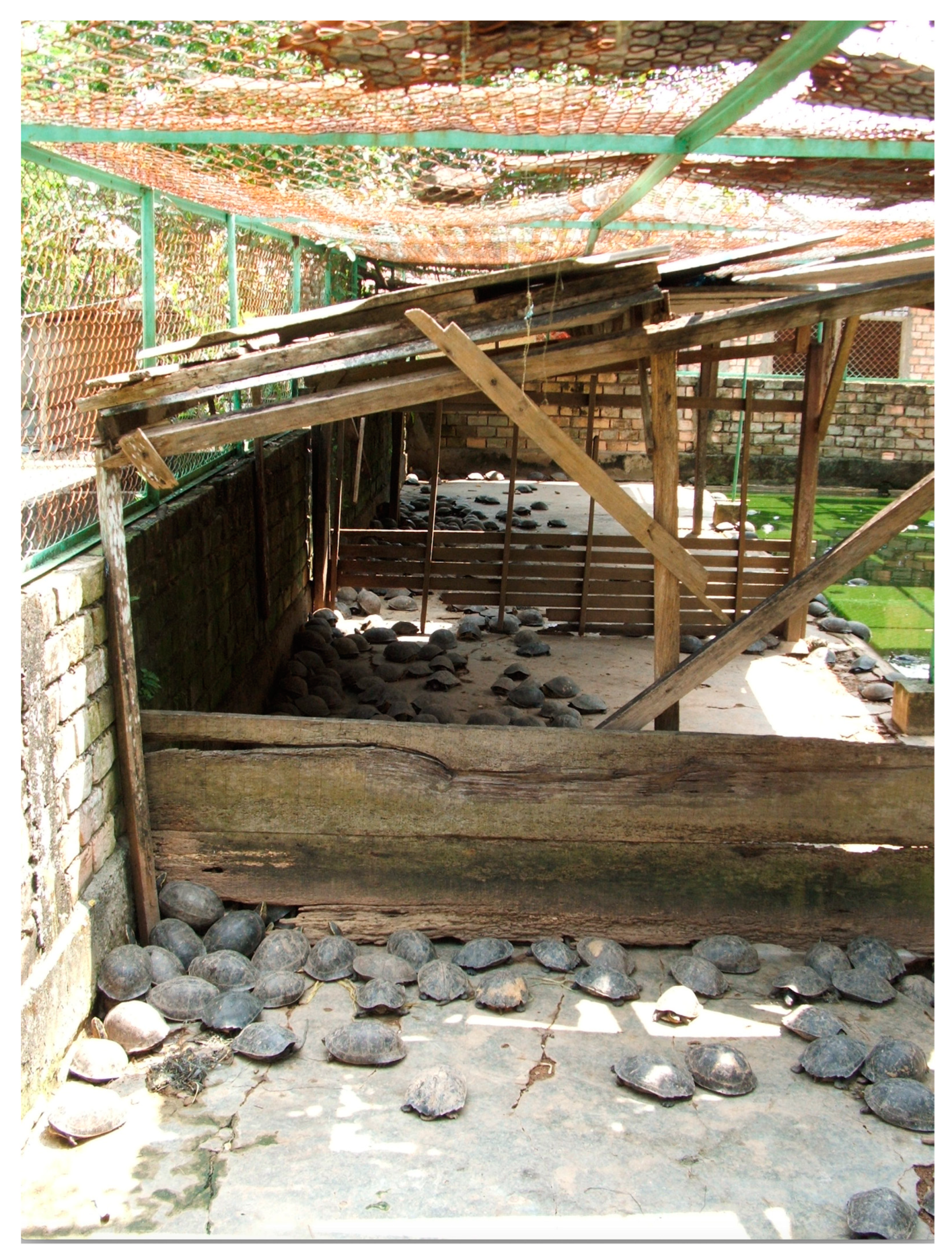Trade in Southeast Asian Box Turtles from Indonesia: Legality, Livelihoods, Sustainability and Overexploitation
Abstract
:1. Introduction
2. Materials and Methods
2.1. Study Region, Species and Distribution
2.2. Data Acquisition and Analysis
2.3. Estimates of the Minimum Number of Box Turtles Harvested in Central Kalimantan
3. Results
4. Discussion
4.1. An Unnoticed Illegal Trade?
4.2. Sustainability, Legality and Management
5. Conclusions
Author Contributions
Funding
Institutional Review Board Statement
Data Availability Statement
Acknowledgments
Conflicts of Interest
References
- Shepherd, C.R. Export of live freshwater turtles and tortoises from North Sumatra and Riau, Indonesia: A case study. Chelonian Res. Monogr. 2000, 2, 112–119. [Google Scholar]
- Jepson, P.; Momberg, F.; Noord, H.V. Trade in Reptiles from the Middle Mahakam Lake area, East Kalimantan, Indonesia, with Evidence of a Casual [sic] Link to the Forest Fires; WWF Indonesia: Jakarta, Indonesia, 1998. [Google Scholar]
- Schoppe, S. The Southeast Asian box turtle Cuora amboinensis (Daudin, 1802) in Malaysia. In NDF Workshop Case Studies, Doc. WG; CITES: Gland, Switzerland, 2008. [Google Scholar]
- Schoppe, S. Status, Trade Dynamics and Management of the Southeast Asian Box Turtle in Indonesia; TRAFFIC Southeast Asia: Petaling Jaya, Malaysia, 2009. [Google Scholar]
- Andersen, S.K.; Staerk, J.; Kalhor, E.; Natusch, D.J.; da Silva, R.; Pfau, B.; Conde, D.A. Economics, life history and international trade data for seven turtle species in Indonesian and Malaysian farms. Data Brief 2021, 34, 106708. [Google Scholar] [CrossRef] [PubMed]
- Fauzi, M.A.; Hamidy, A.; Kurniawan, N. Harvesting trends of Amboina box turtles (Cuora amboinensis) seventeen years after listing in Appendix II CITES. Biodiversitas 2020, 21, 1142–1148. [Google Scholar] [CrossRef]
- Ives, I.E.; Platt, S.G.; Tasirin, J.S.; Hunowu, I.; Siwu, S.; Rainwater, T.R. Field surveys, natural history observations, and comments on the exploitation and conservation of Indotestudo forstenii, Leucocephalon yuwonoi, and Cuora amboinensis in Sulawesi, Indonesia. Chelonian Conserv. Biol. 2008, 7, 240–248. [Google Scholar] [CrossRef]
- Nurazizah, H.; Kusrini, M.D.; Mardiastuti, A. Bycatch of Amboina box turtle (Cuora amboinensis) by fishermen in Rawa Aopa, Southeast Sulawesi. J. Trop. Biodiv. Biotechnol. 2022, 7, 72113. [Google Scholar] [CrossRef]
- Widagti, N. Sustainability of turtle harvesting Cuora amboinensis Daudin 1802 (Testudines: Geomydidae) in exploited area, east Borneo. Widyariset 2011, 14, 367–374. [Google Scholar]
- Fauzi, M.A.; Hamidy, A.; Mumpuni, M.; Kurniawan, N. The threat of Appendix CITES-listed turtles harvesting in Central Borneo and South Sumatra. J. Trop. Life Sc. 2020, 10, 215–222. [Google Scholar]
- Fauzi, M.A. A recent harvest monitoring of Cuora amboinensis in Sumatra and Kalimantan. Indones. J. Environ. Sustain. Develop. 2022, 12, 1–10. [Google Scholar]
- Schoppe, S.; Das, I. Cuora amboinensis (Riche in Daudin 1801)—Southeast Asian box turtle. In Conservation Biology of Freshwater Turtles and Tortoises: A Compilation Project of the IUCN/SSC Tortoise and Freshwater Turtle Specialist Group; Rhodin, A.G.J., Pritchard, P.C.H., van Dijk, P.P., Saumure, R.A., Buhlmann, K.A., Iverson, J.B., Mittermeier, R.A., Eds.; IUCN/SSC Tortoise and Freshwater Turtle Specialist Group: Arlington, TX, USA, 2011. [Google Scholar]
- Karraker, N.E.; Dikari Kusrini, M.; Atutubo, J.R.; Healey, R.M.; Yusratul, A. Non-marine turtle plays important functional roles in Indonesian ecosystems. Ecol. Evol. 2020, 10, 9613–9623. [Google Scholar] [CrossRef] [PubMed]
- Nijman, V.; Shepherd, C.R. Analysis of a decade of trade of tortoises and freshwater turtles in Bangkok, Thailand. Biodiv. Conserv. 2015, 24, 309–318. [Google Scholar] [CrossRef]
- Cota, M.; Hoang, H.; Horne, B.D.; Kusrini, M.D.; McCormack, T.; Platt, K.; Schoppe, S.; Shepherd, C. Cuora amboinensis. The IUCN Red List of Threatened Species 2020: e.T5958A3078812. Available online: https://dx.doi.org/10.2305/IUCN.UK.2020-2.RLTS.T5958A3078812.en (accessed on 5 June 2022).
- Nijman, V.; Shepherd, C.R.; Mumpuni, M.; Sanders, K.L. Over-exploitation and illegal trade of reptiles in Indonesia. Herpetol. J. 2012, 22, 83–89. [Google Scholar]
- Toumbourou, T. Using a Delphi approach to identify the most efficacious interventions to improve Indonesia’s forest and land governance. Land Use Policy 2020, 99, 102768. [Google Scholar] [CrossRef]
- Kendrick, R.C.; Ades, G.W.J. Taxonomic and morphometric analysis of a trade confiscation of turtle shells from Java, Indonesia. TurtleLog 2009, 4, 1–4. [Google Scholar] [CrossRef]
- Sutherland, W.J. Sustainable exploitation: A review of principles and methods. Wildl. Biol. 2001, 7, 131–140. [Google Scholar] [CrossRef]
- Nijman, V. Harvest quotas, free markets and the sustainable trade in pythons. Nat. Conserv. 2022, 48, 99–121. [Google Scholar] [CrossRef]
- Gönner, C. Surfing on the waves of opportunities: Resilient livelihood strategies of Dayak Benuaq forest users in East Kalimantan, Indonesia. In Proceedings of the International Conference of Poverty Reduction and Forest, Bangkok, Thailand, 3–7 September 2007. [Google Scholar]
- Kendrick, R.C.; Ades, G.W.J. Turtle Plastron Study Report 2006–2009; Kadoori Farm and Botanic Gardens: Hong Kong, China, 2009. [Google Scholar]


| Province | Asiatic Softshell Turtle Amyda cartilaginea | Southeast Asian Box Turtle Cuora amboinensis | Asian Leaf Turtle Cyclemys dentata | Malayan Softshell Turtle Dogiana subplana |
|---|---|---|---|---|
| Aceh | 3200 | 0 | 1500 | 200 |
| North Sumatra | 3450 | 1000 | 1000 | 0 |
| West Sumatra | 1200 | 500 | 2000 | 800 |
| Riau | 3000 | 1000 | 1500 | 300 |
| Jambi | 3150 | 1535 | 1000 | 0 |
| South Sumatra | 1500 | 500 | 2000 | 0 |
| Lampung | 0 | 0 | 500 | 0 |
| West Kalimantan | 1200 | 0 | 0 | 0 |
| Central Kalimantan | 2500 | 1000 | 0 | 0 |
| South Kalimantan | 2350 | 1500 | 1500 | 150 |
| East Kalimantan | 4800 | 500 | 0 | 150 |
| West Java | 0 | 0 | 0 | 200 |
| Central Java | 0 | 0 | 0 | 150 |
| Central Sulawesi | 0 | 1500 | 0 | 0 |
| South Sulawesi | 0 | 500 | 0 | 0 |
| Location (Town/Village, Province, Island) | Type | 1997 | 1999 | 2006 | 2019 |
|---|---|---|---|---|---|
| Muara Muntai, E Kalimantan, Borneo | Live, middleman buying | 3.73 | |||
| Kota Bangun, E Kalimantan, Borneo | Live, middleman buying | 1.88–2.00 | 0.69–0.83 | 1.09–1.45 | |
| Sampit, C Kalimantan, Borneo | Live, middleman buying | 0.91 | |||
| Medan, N Sumatra, Sumatra | Live, middleman buying | 2.51 | |||
| Pekanbaru, Riau, Sumatra | Live, middleman buying | 1.74 | |||
| Duri, Riau, Sumatra | Live, middleman buying | 1.53 | |||
| Jakarta, Java | Live, middleman buying | 1.09–1.45 | |||
| Banjarmasin, S Kalimantan, Borneo | Live, exporter buying | 4.66 | |||
| Tembilahan, Riau, Sumatra | Live, exporter buying | 8.30–8.79 | 2.79–3.00 | ||
| Kandis, Riau, Sumatra | Live, exporter buying | 1.88–2.51 | |||
| Medan, N Sumatra, Sumatra | Live, exporter buying | 4.26 | 1.94–2.22 | ||
| Jakarta, Java | Live, exporter buying | 3.40 | 1.82 | ||
| Jakarta, Java | Live, exporter selling | 13.07 | |||
| Medan, N Sumatra, Sumatra | Live, consumer, buying | 5.55–6.94 | |||
| Palembang, S Sumatra, Sumatra | Live, consumer, buying | 5.55 | |||
| Jakarta, Java | Live, consumer, buying | 4.17–8.33 | 6.15 | ||
| Banjarmasin, S Kalimantan, Borneo | Plastron, middleman buying | 5.54 | |||
| Makassar, S Sulawesi, Sulawesi | Plastron, middleman buying | 6.94 | |||
| Banjarmasin, S Kalimantan, Borneo | Plastron, exporter buying | 9.58–9.72 | |||
| Pare-pare, S Sulawesi, Sulawesi | Plastron, exporter buying | 9.03 | |||
| Surabaya, E Java, Java | Plastron, exporter buying | 9.72 | |||
| Sampit, C Kalimantan, Borneo | Meat, consumer buying | 1.06–1.41 |
Publisher’s Note: MDPI stays neutral with regard to jurisdictional claims in published maps and institutional affiliations. |
© 2022 by the authors. Licensee MDPI, Basel, Switzerland. This article is an open access article distributed under the terms and conditions of the Creative Commons Attribution (CC BY) license (https://creativecommons.org/licenses/by/4.0/).
Share and Cite
Nijman, V.; Shepherd, C.R. Trade in Southeast Asian Box Turtles from Indonesia: Legality, Livelihoods, Sustainability and Overexploitation. Diversity 2022, 14, 970. https://doi.org/10.3390/d14110970
Nijman V, Shepherd CR. Trade in Southeast Asian Box Turtles from Indonesia: Legality, Livelihoods, Sustainability and Overexploitation. Diversity. 2022; 14(11):970. https://doi.org/10.3390/d14110970
Chicago/Turabian StyleNijman, Vincent, and Chris R. Shepherd. 2022. "Trade in Southeast Asian Box Turtles from Indonesia: Legality, Livelihoods, Sustainability and Overexploitation" Diversity 14, no. 11: 970. https://doi.org/10.3390/d14110970
APA StyleNijman, V., & Shepherd, C. R. (2022). Trade in Southeast Asian Box Turtles from Indonesia: Legality, Livelihoods, Sustainability and Overexploitation. Diversity, 14(11), 970. https://doi.org/10.3390/d14110970







